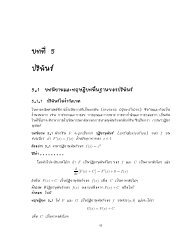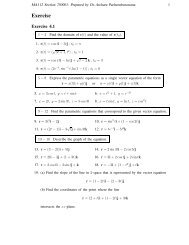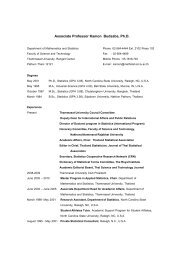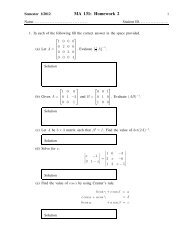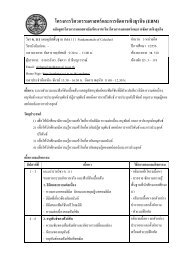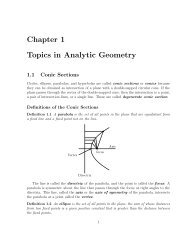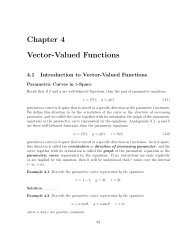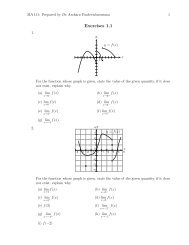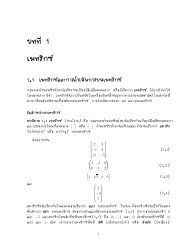Chapter 1 Topics in Analytic Geometry
Chapter 1 Topics in Analytic Geometry
Chapter 1 Topics in Analytic Geometry
Create successful ePaper yourself
Turn your PDF publications into a flip-book with our unique Google optimized e-Paper software.
•MA112 Section 750001: Prepared by Dr.Archara Pacheenburawana 67Geometric Interpretation of the Derivative.Suppose that C is the graph of a vector-valued function r(t) <strong>in</strong> 2-space or 3-space and thatr ′ (t) exists and is nonzero for a given value of t. If the vector r ′ (t) is positioned with its<strong>in</strong>itial po<strong>in</strong>t as the term<strong>in</strong>al po<strong>in</strong>t of the radius vector r(t), then r ′ (t) is tangent to C andpo<strong>in</strong>ts <strong>in</strong> the direction of <strong>in</strong>creas<strong>in</strong>g parameter.yr ′ (t)r(t)CxTheorem 4.2 If r(t) is a vector-valued function, then r is differentiable at t if and only ifeach of its component functions is differentiable at t, <strong>in</strong> which case the component functionsof r ′ (t) are the derivatives of the correspond<strong>in</strong>g component functions of r(t).Example 4.9 F<strong>in</strong>d the derivative of r(t) = s<strong>in</strong>(t 2 )i+e cost j+tlntk.Solution .........Derivative RulesMany of the rules for differentiat<strong>in</strong>g real-valued functions have analogs <strong>in</strong> the context ofdifferentiat<strong>in</strong>g vector-valued functions. We state some of these <strong>in</strong> the follow<strong>in</strong>g theorem.Theorem 4.3 (Rules of Differentiation). Let r(t), r 1 (t), and r 2 (t) be vector-valuedfunctions that are all <strong>in</strong> 2-space or all <strong>in</strong> 3-space, and let f(t) be a real-valued function, k ascalar, and c a constant vector (that is, a vector whose value does not depend on t). Thenthe follow<strong>in</strong>g rules of differentiation hold:(a)(b)(c)(d)(c)ddt [c] = 0ddt [kr(t)] = k d dt [r(t)]ddt [r 1(t)+r 2 (t)] = d dt [r 1(t)]+ d dt [r 2(t)]ddt [r 1(t)−r 2 (t)] = d dt [r 1(t)]− d dt [r 2(t)]ddt [f(t)r(t)] = f(t) d dt [r(t)]+r(t) d dt [f(t)]



